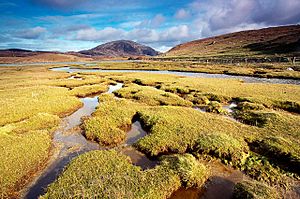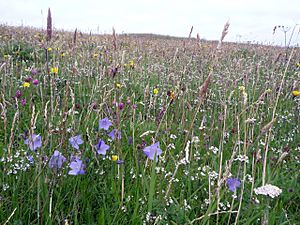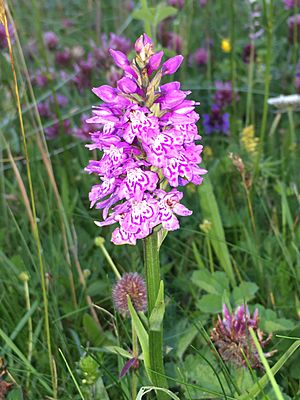Machair facts for kids
Machair (pronounced "MACK-air") is a special kind of flat, grassy land. You can find it along the northwest coasts of Ireland and Scotland. It's especially common in the Outer Hebrides, a group of islands in Scotland.
Machair land is very fertile, meaning it's good for growing plants. It's also low-lying, close to the sea. Some of the best examples are on islands like North and South Uist, Harris, and Lewis.
Contents
What Does Machair Mean?
The word "machair" comes from a Gaelic word. It means "fertile plain." Scientists now use this word to describe this unique type of grassland. It's found only in Western Scotland and northwest Ireland.
Naturalists started using the term in 1926. Scientists officially adopted it in the 1940s. You might even see "machair" in place names in Ireland and Scotland. This happens even in areas where machair land doesn't exist anymore.
In Scotland, some Gaelic speakers use "machair" for the whole sand dune system. This includes the sandy hills. Others use it only for the flat grasslands behind the dunes. In Ireland, the word was mostly used in place names. Scientists only recently confirmed that this habitat exists there.
In 1976, people tried to define machair very strictly. But some areas still didn't fit the definition. This caused problems when machair was listed as a special habitat in 1992. So, they made a difference between "machair grassland" and the larger "machair system."
Where is Machair Found?
Machair is different from "links" land found on Scotland's east coast. Links land has more silica, a common mineral. Machair plains, however, have a lot of calcium carbonate. This is a substance found in shells.
The sand on machair beaches can be 20% to 80% calcium carbonate. This amount goes down as you move away from the shore. Machair soil is usually alkaline, meaning its pH is higher than 7.
The inner part of a machair is often wet or marshy. It might even have small lakes called lochs.
How Machair Forms
The main idea of how machair forms came from William MacGillivray in 1830. He figured out that waves roll shell pieces onto the shore. These pieces break into smaller fragments.
Then, the wind blows these small shell fragments up the beach. They form small hills. Over time, these sandy hills are blown further inland. This process creates the flat, fertile machair plains.
How Humans Help Machair
People have played a big part in creating machair. Old records show that some trees were cleared for farming around 6000 BC. But there were still some forests on the coast of South Uist in 1549.
Early farmers put seaweed on the land. This seaweed protected the soil and added nutrients. Cattle and sheep keep the grass short. Their hooves also create bumps in the grass. These bumps are good for many bird species.
The sandy soil of machair doesn't hold nutrients very well. It's low in important elements like copper and manganese. Because of this, farmers often give cattle extra food. Sometimes, they move the cattle to other pastures in summer.
The soil also makes it hard to use artificial fertilizers. Only certain types of oats, rye, and bere barley can grow well here.
Machair Ecosystems
Machairs are very important for ecology and conservation. This is because they have unique ecosystems. An ecosystem is a community of living things and their environment.
The Sea's Role
Kelp, a type of seaweed, grows in the sea near machair. It helps to soften the impact of waves. This reduces how much the land wears away. When storms wash kelp onto the shore, it forms a protective barrier.
As the kelp rots, it becomes a rich food source. Many birds, like starlings, waders, and gulls, feed on the insects that live in the rotting kelp. If sand covers the kelp, it turns into fertile soil. This helps coastal flowers and marram grass to grow.
Plants of the Machair
Machairs are home to many rare and beautiful plants. You can find colorful carpet flowers here. Many types of orchids grow on machair, too. These include the Irish lady's tresses and the Hebridean Spotted Orchid. Other plants like the yellow rattle also thrive here.
Animals of the Machair
Many interesting animals live on machair. Bird species include the corn crake, twite, dunlin, common redshank, and ringed plover. Rare insects also call machair home. These include the northern colletes bee, the great yellow bumblebee, and the moss carder bee.
Threats to Machair
Machair is facing some dangers. One threat comes from changes in how the land is managed. The traditional system of small farms called crofts is changing. There are fewer crofters, and people are using "modern" farming methods.
Changes to farming rules have also reduced how much grazing happens. This means some areas are not grazed enough or are left empty. A lack of native plant seeds means farmers need to use more fertilizers and weed killers.
Rising sea levels due to global warming are another big threat. Low-lying coastal areas like machair are at risk of more erosion. For example, in January 1993, a storm caused 3 meters (about 10 feet) of machair to wash away along the Uist and Barra islands. Another powerful storm in January 2005 destroyed large areas of machair.
Images for kids
See also
 In Spanish: Machair para niños
In Spanish: Machair para niños







